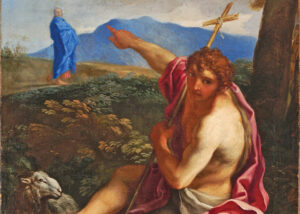For most of us, the biblical canon with its 66 “books” has always been a given, inherited from the past, our parents and churches. We have not concerned ourselves very much with it, even though we may have heard that the Catholic version of the Bible has more “books” in it than the Protestant version.
Some of us may not have heard that there have been disagreements about the makeup of this collection of writings we consider to be Scripture. Around AD 400, there was disagreement about including the Book of Revelation in the Bible. And in the 16th century, Martin Luther argued against the inclusion of the Book of James; Luther had difficulty with James’s focus on “works,” and he spoke of it as “a right strawy epistle.”
The Catholic Church has considered the apocryphal books—books not part of the Hebrew Old Testament but included in the Greek translation, including I and II Esdras and I-IV Maccabees—as part of the inspired canon. Nowadays, many study Bibles include these books.
From time to time someone may raise the question, “Is the canon permanently closed?” However, most Protestants accept the 66 books in the Bible as inspired, authoritative and closed—the norm for an orthodox Christian faith. This “closing of the canon” occurred around AD 400. The Old Testament had been officially “closed” at the Council of Jamnia, in AD 90, by the Jewish community; not all scholars agree on this.
For many of us, questions about the biblical canon seem unimportant, even irrelevant: We simply accept the canon as a given, inspired and authoritative. We may pay lip service to the Bible as a whole, but we have to admit that most of us have a smaller “canon within the canon” and we avoid or ignore parts of Scripture! There are parts of the Bible that we really appreciate and then there are parts, even whole books, to which we pay virtually no attention! This practice continues even though we claim to believe what II Timothy 3:16-17 says: “All scripture is inspired by God and useful . . . .”
However, during the past two decades, those of us within Mennonite Church Canada have given a lot of attention to the Bible. Here is part of what I mean: We spent years on the Being a Faithful Church (BFC) process and gave careful attention to how we understand Scripture (Paths and Ditches, 2013); the 2012 MC Canada assembly theme was “Dusting off the Bible”; and the late Dick Benner wrote an editorial entitled “What about this Bible of ours?” I wrote a three-part series in 2009, “Do you understand what you are reading?” published in Canadian Mennonite; and, most recently, editor Virginia A. Hostetler wrote an Oct. 28, 2019 editorial in which she quoted the Confession of Faith in a Mennonite Perspective: “The Bible is the essential book of the church.”
Hostetler reminded us of our commitment to delight in the study of the Bible and to devote ourselves to it. Benner urged us to give high priority to the task of refurbishing our understanding and application of Scripture, calling for “fresh interpretation, new imagination, new inspiration and new application.”
But as far as I can tell, this wealth of material does not give serious attention to the canon as a whole. Isn’t it time to revisit our understanding of the canon?
Affirmations about the canon
We affirm that this body of literature is inspired and authoritative for all believers, for growth in faith and discipleship. The canon provides roots and resources for our faith. As such, it is basically understood as having “canonized” the content, and the impression is that the content of our faith is settled and fixed. Some even appeal to the expression in Jude verse 3: “the faith that was once for all entrusted to the saints.” The canon is the fixed content of both Old and New Testaments. This is the explicitly given foundation for Christian faith and life.
As I’ve been working with specific passages and thinking about the canon as a whole, I wondered whether there is actually more to the canon than canonical content. This dawned on me while giving a presentation in an adult-education setting in one of our churches on the topic, “Reading the Bible responsibly.”
I have the growing conviction that the canon provides us not only roots, but also wings. Not only is it important to be “well-rooted”; it is equally important to be “well-winged.” Let’s consider the possibility that, in addition to the explicitly given biblical content, the canon offers us more than explicit foundational truth, the roots of our faith. Perhaps the canon implicitly also offers us wings in addition to the roots. There is help available in the canon for necessary interpretation.
Deepening our understanding of the canon
My interest in going beyond my earlier understanding of the canon was an outgrowth of studying more carefully and comparatively what is written in the Bible. What I noticed about the inspired canon, this ancient anthology of literature, is that it’s not static, but dynamic.
Diversity and development are preserved in the canon for our benefit. At times, I have been surprised by what’s in the inspired texts; at times, I have been disturbed and upset by what I was learning. At times, I realized I was having “second thoughts” about things I thought I was fairly certain about.
When I go beyond seeing the Bible as having foundational content for my life of faith and discipleship, I learn that in the Bible diversity is somehow authoritative, or canonized. I notice that tensions between texts are not resolved. I see in Scripture that faith and practice develop over time in the light of the coming of Jesus! All of these realities call for interpretation.
Diversity
Here are some examples:
- There are texts that urge the people of God to be exclusionary, to be separate and to avoid certain people; and then there are texts, like Isaiah 56:3-7, that urge inclusion of those formerly excluded.
- There are texts that portray God as being violent and genocidal, while others, like Jonah 4, confess God to be “gracious and merciful, slow to anger and abounding in steadfast love.”
I have found it necessary to wrestle with these details, to try to understand them since the canon models diversity.
Change
Two examples illustrate that the inspired canon also endorses change and development, one from Nehemiah 8 and the other from Acts 10-11:
- Nehemiah 8 tells of the return of exiles from Babylon to Palestine. On the one hand, the people must have been jubilant—they’re back in the Promised Land; but, on the other hand, they were confused, trying to understand ancient understandings, preserved in Torah, with their recent difficult experiences.
The people asked their leaders to read Torah to them. What did the leaders do? Ezra and the others responded wisely: “So they read from the book, from the law of God [Torah] with interpretation. They gave the sense so that the people understood the reading” (Nehemiah 8:8).
Utterly amazing! They added something to the ancient texts—interpretation—so that the people understood their new circumstances and their recent tragic history in the light of the unchanging Torah.
What impresses me about this passage is that it legitimizes adaptation of Torah in the light of changed circumstances and shows that canonized content is not static, but dynamic! The passage shows me that Torah provides wings as well as roots!
- The other incredible story is about Peter and Cornelius, especially how Peter, who was deeply steeped in Jewish faith and tradition, underwent a radical shift in his beliefs about God and his views of gentiles.
When the vision of the sheet came to him in a trance, his immediate reaction was: “By no means Lord, I have never eaten anything unclean.” Finally, Peter did what he had declared he would not do. He went to Cornelius’s home and shared the good news. Peter also shared his own new insight with the extended gentile family: “I truly understand that God shows no partiality . . . anyone who fears him and does what is right is acceptable to him” (Acts 10:34-35) .
My understanding of canon has been transformed. Not by adding new books to the biblical canon, but by being overwhelmed by seeing not only that canonical content is inspired and authoritative, but also that diversity, tensions between texts (ambiguity), change and development over time in the light of new circumstances, are also inspired and canonical.
I feel like the Israelites in Nehemiah 8. They celebrated their new understandings with great rejoicing! With a barbecue.
And more
I wonder whether this new way of looking at the canon could serve as a model for thinking about how we do church together. I am thinking particularly about the challenge of accepting diversity, as well as recognizing the validity of change and development over time, in response to new circumstances and fresh insights.
Before retirement, John H. Neufeld served as pastor of First Mennonite Church, Winnipeg, (1969-84), and as president of Canadian Mennonite Bible College (now Canadian Mennonite University [CMU], 1984-97). In the last two decades, he has made presentations on aging, the Book of Revelation, and reading the Bible responsibly in a variety of settings. This article is adapted from an essay, “Exploring the meaning of canon,” that was presented to the emeritus professors at CMU last fall.
For discussion
1. What are some of your favourite Bible verses? Are there parts of the Bible that you tend to ignore? What are some passages that seem to be over- or under-used in sermons? How do you understand II Timothy 3:16-17?
2. John H. Neufeld writes that the Old Testament canon was closed around AD 90 and the New Testament around the year AD 400. Why do you think it was important for the church to clearly define the books of the Bible? Do you find it unsettling to think that this decision was made by humans? If you were compiling a list of meaningful sources for the church today, what would you include?
3. Neufeld says the Bible should provide us with wings as well as roots. How does it give us roots? How is this rootedness helpful when we come across conflicts or alternate interpretations?
4. What do you think Neufeld means with his statement that the Bible provides us with wings? How did Nehemiah and Peter bring new understanding to ancient texts? Can you think of examples of new interpretations of biblical passages that can speak to us in a fresh way?
—By Barb Draper
—Updated May 20, 2020








Leave a Reply
You must be logged in to post a comment.